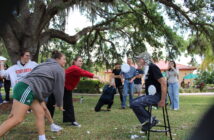The origin of the dream catcher is difficult to trace since Native American tribes have lost much of their culture due to disease and persecution. The dream catcher we know today first gained popular notice in the Pan-Indian movement of the 1960s and 1970s. The idea behind the movement was that no matter the tribe, Native Americans were united. The modern known style of dream catcher was first made by the Ojibwa (Chippewa) and was seen by some Natives as a symbol of unity. Another opinion, however, in the Native American community is that dream catchers are being mistreated by those who are not of Native American decent. The original dream catchers were constructed from red willow wood and animal sinew, and then after completion they were placed over the sleeping area where the suns first rays would hit it. The dream catcher would attract all dreams to the web. The bad dreams got caught in the webbing and were destroyed with the suns light. The good dreams would drip down the feathers to the sleeper below.
Page Ramesy-Hamacher, who was in charge of putting together the event, said that dream catchers are “a neat way to learn about Native American Culture and the students really enjoy it.” Indeed, they did. Many were crowded around the table just inside the entrance to the dining hall, making their very own dream catchers.
Yet how much do people really know about Native Americans? When asked if he felt that Native Americans were repressed, Cam Silver, an international studies and history major said, “Yes, from the start of the Mayflower.”
Silver also stated that he had a dream catcher of his own.
The Native Americans had established themselves here many centuries before the first European explores. This, however, meant that the Native American population did not have any immunity to the diseases brought over by the Europeans. Indeed, many smaller tribes died out from a combination of disease and superior weapons. The larger tribes fought or moved away from the invaders, which caused turmoil and conflict with other tribes further inland. Over time, as America expanded more and more indigenous people were displaced, eventually most Native Americans were forced on to reservations in Oklahoma or Arizona.
Today, there are many tribes on the comeback that are regaining their cultural identity, despite the main stream stereotypes portraying them as savages or casino runners. If one were to spend time on a reservation, one might get a different picture. Some tribes have integrated well into American society and are very successful in businesses that they pass on to tribal members. If one is interested in Native American history, art, or culture, there are many excellent books about many different tribes. The Native American dream catcher has become a very popular symbol of Native culture.




